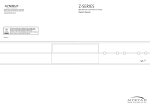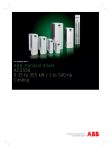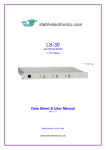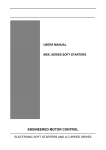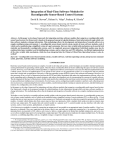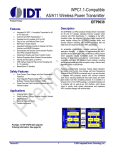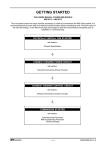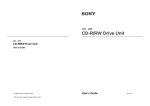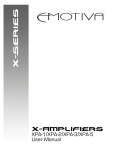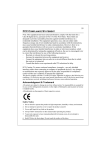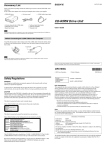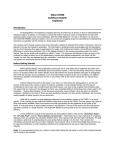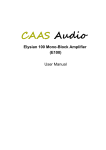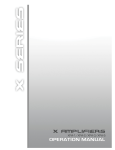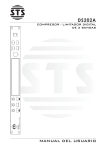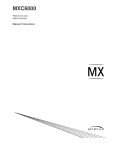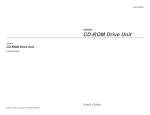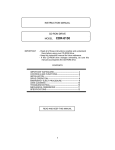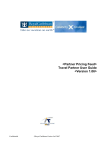Download CDU 5211 User Manual .indd - Pdfstream.manualsonline.com
Transcript
CDU 5211 Series CDU 5211 Series CD-ROM Drive User’s Manual NOTE: This manual is subject to change without notice. Revision 1 Copyright 2001 - Sony Australia Printed in Australia Owner’s Record The model and serial numbers are located on the topside of the drive. Record these numbers in the space provided below. Refer to them whenever you call upon your sales representative regarding this product. Model No._________________ Serial No. _______________ WARNING To prevent fire or shock hazard, do not expose the unit to rain or moisture. To avoid electrical shock, do not open the cabinet. Refer servicing to qualified personnel only. CAUTION The use of optical instruments with this product will increase eye hazard. The use of controls or adjustments or performance of procedures other than those specified herein may result in hazardous radiation exposure. This unit uses CD-ROM discs with the following mark. When you use this unit as an audio CD player, use compact discs with the following mark. CAUTION LASER RADIATION WHEN OPEN. DO NOT STARE INTO BEAM This label is located on the drive unit’s internal chassis. ATTENTION Dieses Etikett befindet sich auf dem inneren Chassis des Laufwerkes RAYONNEMENT LASER EN CAS D’OUVERTURE. NE PAS REGARDER DANS LE FAISCEAU. CAUTION VORSICHT ADVARSEL ADVARSEL VARNING VARO! © 2001 - Sony Australia INVISIBLE LASER RADIATION WHEN OPEN. DO NOT STARE INTO BEAM OR VIEW DIRECTLY WITH OPTICAL INSTRUMENTS. UNSICHTBARE LASERSTRAHLUNG, WENN ABDECKUNG GEÖFFNET. NICHT IN DEN STRAHL BLICKEN, AUCH NICHT MIT OPTISCHEN INSTRUMENTEN. USYNLIG LASERSTRÅLING VED ÅBNING SE IKKE IND I STRÅLEN-HELLER IKKE MED OPTISKE INSTRUMENTER. USYNLIG LASERSTRÅLING NÅR DEKSEL ÅPNES. STIRR IKKE INN I STRÅLEN ELLER SE DIREKTE MED OPTISKE INSTRUMENTER. OSYNLIG LASERSTRÅLNING NÄR DENNA DEL ÄR ÖPPNAD. STIRRA EJ IN I STRÅLEN OCH BETRAKTA EJ STRALEN MED OPTISKA INSTRUMENT. AVATTAESSA OLET ALTTIINA NÄKYMÄTTÖMÄLLE LASERSÄTEILYLLE. ÄLÄ TUIJOTA SÄTEESEEN ÄLÄKÄ KATSO SITÄ OPTISEN LAITTEEN LÄPI. © 2001 - Sony Australia This label is located on the top of the drive. Dieser Aufkleber befindet sich an der Oberseite des Gehäuses. 1 ACKNOWLEDGMENTS & TRADEMARKS All contents are subject to change at any time without notice. No responsibility is assumed for its use; nor for infringements of patents or other rights of third parties and no patent or license is implied hereby. All trademarks are the property of their respective owners. INFORMATION You are cautioned that any changes or modifications not expressly approved in this manual could void your warranty covering this equipment. Note: This equipment has been tested and found to comply with the limits for a Class B digital device, pursuant to Part 15 of the FCC Rules. These limits are designed to provide reasonable protection against harmful interference in a residential installation. This equipment generates, uses, and can radiate radio frequency energy and, if not installed and used in accordance with the instructions, may cause harmful interference to radio communications. However, there is no guarantee that interference will not occur in a particular installation. If this equipment does cause harmful interference to radio or television reception, which can be determined by turning the equipment off and on, the user is encouraged to try to correct the interference by one or more of the following measures: Re-orient or relocate the receiving antenna. Increase the separation between the equipment and receiver. Connect the equipment into an outlet on a circuit different from that to which the receiver is connected. Consult the dealer or an experienced radio/TV technician for help. CLASS 1 LASER PRODUCT LASER KLASSE 1 PRODUKT This CD-ROM Drive Unit is classified as a CLASS 1 LASER PRODUCT. The CLASS 1 LASER PRODUCT label is located on the top of the drive. Safety Notice 1. Do not install or operate the product in high temperature, humidity or dusty environment. 2. Do not attempt to open the cover to repair the product yourself. 3. Never spill liquid of any kind on the product. 4. Always follow instructions on this manual under operating the product. 5. To prevent exposure to laser emanations (harmful to human eyes), do not attempt to disassemble this unit. 6. Hold CD discs by their edges. Do not touch the surface of the discs. 7. The drive is designed to be incorporated into a computer-based system or unit which has an enclosing cover. Using the drive alone or in any other configuration is prohibited. Caution: Use of controls or adjustments or performance of procedures other than those specified herein may result in hazardous radiation exposure. 2 © 2001 - Sony Australia © 2001 - Sony Australia 3 CONTENTS Warnings and Precautions 7 Introduction 8 Features ............................................................................................................8 Software Requirements....................................................................................9 Using the Drive 10 Front Panel .....................................................................................................10 “Maximum Speed Choice” function..............................................................11 Installing the Drive 12 System Requirements.....................................................................................12 Hardware Installation.....................................................................................12 Connections & Settings .................................................................................13 Connecting the IDE cable ..............................................................................14 Trouble Shooting 15 Specifications 16 General...........................................................................................................16 Performance ...................................................................................................16 Audio..............................................................................................................16 Reliability.......................................................................................................16 Power Requirements ......................................................................................16 Environmental Conditions .............................................................................17 Dimensions & Mass.......................................................................................17 4 © 2001 - Sony Australia © 2001 - Sony Australia 5 WARNINGS & PRECAUTIONS WARNING - Possible voiding of Warranty Please be aware that cracked, deeply scratched or other poor quality discs used in this drive may cause damage to the drive and / or the data on the disc. Such discs may break at high speed rotation. If full care is not exercised in relation to this matter you may void the warranty of this product. PRECAUTIONS · · · · · · 6 © 2001 - Sony Australia Do not attempt to open the drive and service it. Removing the cover may cause exposure to harmful laser beams and electrical voltages. User is recommended to get service by returning the defected drive back to the original vendor where the drive is purchased. Use the original packing for transporting the drive or sending back for service. The original packing were designed and tested to protect your drive under rough conditions. Do not put this CD-ROM drive in direct sunlight, on heat units, or near electrical appliances which draw large amounts of current. Keep your discs clean. Using soft, dust-free cloth to clear the surface of the disc. Do not drop or jolt the drive. Keep the area around the CD-ROM drive clean from dust, smoke, and other contaminants. © 2001 - Sony Australia 7 INTRODUCTION INTRODUCTION Features The CDU 5211 is an internal CD-Rom (Compact Disc - Read Only Memory) drive unit designed for use with personal computers. It comes with the following features: General • Speed: 52X max / 40X default. • “Maximum Speed Choice” function. • 40 Pin ATAPI - IDE interface. • 5 1/4 inch half-height drive form factor. • Power loading and eject of a disc. • ABS (Auto Balance Spindle) to reduce noise and vibration. • 128 KB of buffer memory. • Power saving functions. • Vertical mount ability. • Small CPU bandwidth consumption. • Software volume control. • Easy audio CD-DA control button. Supported Disc Formats The CD 5211 is a “Multiread” compliant drive and can read data in each of the following formats: CD-DA, CD-ROM Mode-1, CD-ROM/XA Mode-2 Form-1 & Form-2, CDI-Ready, Photo-CD, Karaoke-CD, Video CD (MPEG-1), Enhanced CD, CD Extra, I-Trax CD, CD-Text, UDF. Media Types Software Requirements Reading Data For your computer to recognise your new CD-Rom drive and to be able to access data from it, the correct device drivers must be installed. Most modern operating systems such as Microsoft® Windows 95™, Windows 98™, Windows ME™, Windows NT4™ and Windows 2000™ along with most versions of Linux and OS/2™ include these drivers as standard in the operating system, hence no additional drivers are required for reading discs on these operating systems. Windows 3.xx™ and MS-DOS™ If you require the drive to be recognised by Microsoft Windows 3.xx or MS-DOS you will need to install the MS-DOS™ device driver. It can be downloaded from our support web site: http://www.sony.com.au/support/itp NOTE: If using Windows 95 or later and you have previously installed the MS-DOS device driver it is recommended that you disable or remove MS-DOS device driver as it will decrease performance. CD-ROM, CD-R and CD-RW. 12cm & 8cm discs. Audio • • 8 Outputs 16-bit digital data over the ATA interface. Audio line output (rear panel) and headphones jack (front panel) for audio CD playback. © 2001 - Sony Australia © 2001 - Sony Australia 9 USING THE DRIVE USING THE DRIVE Front Panel “Maximum Speed Choice” function The CDU-5211 has a Maximum Speed Choice function where the user can select between maximum speeds of 40X or 52X. The drive always defaults to 40X. To activate 52X operation press and hold the Stop/Eject button for 5 seconds. The drive will then read the current disc at 52X speed. When the disc is ejected the drive will default back to 40X operation. 2 1 3 4 5 6 7 1 - Earphone Jack Stereo mini-jack for headphones and/or powered speakers. 2 - Volume Control volume of earphone jack. This control has no effect on rear panel audio output. 3- Control Emergency Eject In case the Eject button isn’t working, insert a small It is recommended that 52X operation only be activated under the following conditions You are confident that the disc been used is in good condition and free from marks and scratches. The disc is well balanced and does not have thick printed ink or adhesive labels attached to its surface. The disc is not physically damaged in any maner. paper clip into this hole to eject the tray. Note: Turn off the power before doing this manual ejection. Discs that have the above characteristics may reduce maximum transfer speeds due to excessive disc vibration at 52X. 4 - On/Busy LED The On/Busy LED will be flashing while the CD-ROM drive is busy. NOTE: Physically damaged discs may void warranty - refer to “Warnings & Precautions” on page 7 of this manual. 5 - Disc Tray The user can open or close the disc tray by pressing the Open/Close button. 6 - Play/Skip Will start playing of an Audio-CD or Skip to next track if already playing an Audio-CD. 7 - Stop/Eject/Speed Will eject the tray if a CD-ROM is playing. Will stop an Audio-CD playing, pressing it again will eject the tray as usual. Pressing this button can also change the max drive speed. The default max speed is 40X. Press and hold for 5 seconds to change the drive speed from 40X to 52X. Tray out disc will reset drive speed from 52X to 40X automatically. 10 © 2001 - Sony Australia © 2001 - Sony Australia 11 INSTALLING THE DRIVE INSTALLING THE DRIVE System Requirements Connections and Settings To ensure stable performance, the following system specifications are recommended. There are three pairs of jumpers, MA (Master), SL (Slave) and CS (Cable Select) on the rear panel of your CD-ROM drive. Figure 1 shows the location of each jumper. OS Interface DOS 6.xx or higher, Windows 3.1x, 95/98/ME/2000/ NT 4.0, OS/2 Warp 3.0 or higher. Vacant IDE interface connector NOTE: To operate the drive using DOS 6.xx or higher you will need to install the DOS device drivers. These are available for free download from our support web site: http://www.sony.com.au/support/itp Rear of Drive Cable Select Slave Master Analogue Audio Digital Audio DC C S M S L A RCCL POWER HOST INTERFACE 39 40 1 2 +5 G G +12 Hardware Installation Please refer to your PC’s user manual and follow their guidelines for adding hardware components. Always follow their anti-static precautions. 1 Set the Master/Slave jumper on CD-ROM rear panel (refer to figure 1) 2 Locate an empty drive bay and slide the CD-ROM drive into the bay. Secure with four screws. 3 Connect the power supply cable to the CD-ROM drive. (Ensure the pin definition of power connector is the same as shown in figure 1). 4 Connect the 40 pin IDE / ATAPI cable to the CD-ROM drive according to the description in figure 1 (Note: Pin 1 on the cable is generally indicated by a red stripe along the edge of the ribbon cable). 5 Connect the sound cable from the Analog Audio on the rear panel of CD-ROM to your sound card (if you have a sound card in your system). 6 Follow you PC’s user manual to re-assemble your PC. C S S L M A Master Device (Factory default setting) C S S L M A Slave Device Figure 1 CS (CSEL) If your system supports the CS setting you can set the jumper to the “CS” position. The Master/Slave setting will then be made automatically depending on your hardware Configuration. No jumper is then required on the “MA” or “SL” pins. NOTE: For optimum performance on Windows based systems the drives DMA setting in the device manager should be enabled. Refer to your Systems help menu for assistance. 12 © 2001 - Sony Australia © 2001 - Sony Australia 13 INSTALLING THE DRIVE TROUBLE-SHOOTING Connecting the IDE cable Most PC systems can connect up to 4 devices on the IDE ports. Your PC should consist of a “Primary IDE Bus” and a “Secondary IDE Bus” each of which can have two devices connected to it - a “Master device” and a “Slave device” Refer Figure 2 If you experience any trouble during installation or normal use of your CD-ROM drive, please refer to the following information. You will find further information on our support web site: http://www.sony.com.au/support/itp In most PC systems, the hard disk drive is set as the “Master Device” on the “Primary IDE Bus”, this should not be altered. Symptoms Action If available it is recommended that you connect the CD-ROM drive as the “Master Device” on the “Secondary IDE Bus”. CD drive not recognised by system. The CD-ROM drive can also be set as the “Slave Device” on either bus if both of the “Master Device” possibilities have been taken by other devices. Some devices such as CD writers and DVD drives may be required to be set as the “Master Device”, in this case it is OK to set the CD-ROM drive as the “Slave Device”. Check IDE interface connections. Check the MASTER/SLAVE settings of all devices. The disc tray will not open . Disable the “lock eject” feature software of the operating system. Shut power down and use emergency eject hole to eject disc. Cannot read data on discs. Check the surface of CD media, always keep it clean and free from scratches. Check the quality of CD media. Check if other discs or music CD’s are reading OK. Is Disc inserted upside down? Could disc be a UDF formatted disc? Check if a UDF reader is installed. No sound. Check sound cable connections. Check the volume settings of the drive and operating system volume controls. Are speakers turned on? Appears to have no power. Device 2 (Slave) Device2 (Slave) Hard Disk (Master) Device 1 (Master) Check DC power cable connection. Secondary IDE Bus Primary IDE Bus PC Mother Board Figure 2 14 © 2001 - Sony Australia © 2001 - Sony Australia 15 SPECIFICATIONS General Host Interface Acceptable Formats Acceptable Media Types Acceptable Disc Diameters Performance Rotational Speeds Random access time Data Buffer Burst Data Rate SPECIFICATIONS ATA-PI compliant. CD-DA, CD-Rom mode 1, CD-Rom/XA mode 2 form 1 & form 2, CD-I Ready, Video CD (MPEG-1), Karaoke CD, Photo CD, Enhanced CD, CD extra, I-Trax CD, CD-Text and UDF. CD-Rom, CD-R, CD-RW, 12 cm and 8 cm. Environmental Conditions Operating Non Operating Temp Humidity Altitude Temp Humidity Altitude 5°C to 45°C 10% to 80% RH 0 ~ 3,500 m -35°C to 60°C 10% to 90% RH 0 ~ 12,500 m Dimensions & Mass Dimensions CD-Rom, Max - 52X, 7800 KB/sec. CD-Rom, Max - 40X, 6,000 KB/sec. 80 ms. 128 KB. Ultra DMA33.3 MB/sec. DMA mode 2- 16.6 MB/sec. PIO mode 416.6 MB/sec. 145.8 x 41.3 x 190 mm (WxHxD +/- 0.5mm) Weight 0.9Kg 5. MECHANICAL DRAWINGS Audio Earphone Output (Front) Line Output (Rear) Digital Output 0.7 +/- 0.2 VRMS @ 33Kohms, 1KHz, 0db 0.7 +/- 0.2 VRMS @ 47Kohms, 1KHz, 0db 5.0 Vp-p - SPDIF Standard Reliability Error Rate MTBF Mode-1 (ECC on) 10 -12 Block/Bit Mode-2 (ECC off) 10 -9 Block/Bit 70,000 POH @ 25% duty cycle Power Requirements Operation Max Sleep Average Voltage Requirements +5V +12V +5V +12V +5V +12V 16 = 1.0 amps = 1.5 amps = 0.03 amps = 0.01 amps +/- 5% and less than 100m Vp-p ripple voltage +/- 10% and less than 200m Vp-p ripple voltage © 2001 - Sony Australia © 2001 - Sony Australia 17










